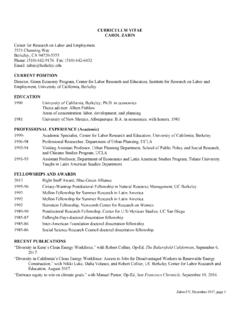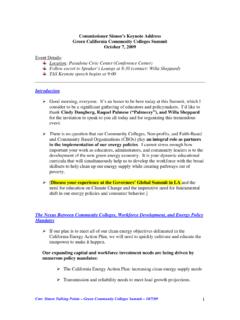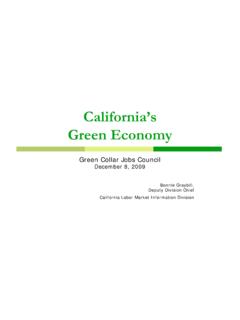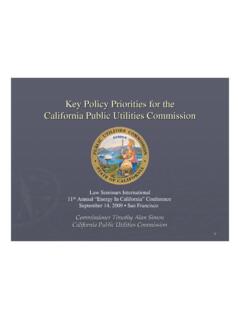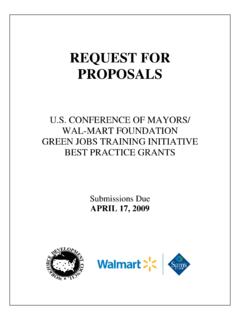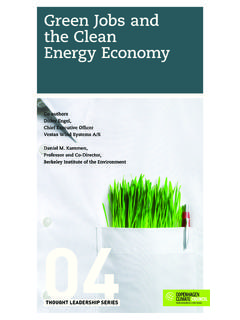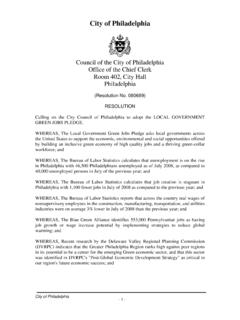Transcription of Green Collar Jobs Council (DRAFT) Guiding Principals
1 Green Collar jobs Council Prop. 39 and other Energy Efficiency and Clean Energy Guiding Principles and Strategies for jobs and Workforce Development December 2012 This document outlines strategies that can help California generate the greatest quantity of good jobs from Prop 39 funding and other clean energy programs, and improve job opportunities for low-income Californians. These recommendations are based on extensive research on workforce development in the clean energy sectors and the results of American Recovery and Reinvestment Act (ARRA) and other Green jobs programs.
2 Prop. 39 provides a clean slate to implement best practices that maximize positive job impacts and address inequality. We highlight the need to address the following job impacts: Quantity of jobs : Energy efficiency and clean energy investments generate about ten to twelve jobs per million dollars of annual investment. While Prop. 39 can generate jobs across California, we caution against over-promising on the number of jobs , particularly the number of new entry-level jobs . The more Prop. 39 funds are matched with private investment, the more jobs Prop.
3 39 will produce. Quality of jobs : Energy efficiency and clean energy investments produce good jobs when there are clear skill certifications for workers and performance standards for participating contractors. These standards are also key to insure that high quality work is performed and energy goals are met. Access to jobs for targeted groups: Youth, veterans, women and disadvantaged workers can gain access to jobs through a combination of workforce development services (training, case management, and job placement) and targeted hire policies and/or jobs programs specifically designed for entry-level workers.
4 This explicit linkage of training-to- jobs is necessary to maximize opportunities without raising false hopes for placing graduates in jobs . As some Green training programs illustrated, training alone cannot create jobs . The great majority of funds should be spent on energy efficiency and clean energy investments that create jobs . A key element of Prop. 39 s workforce strategy should be setting standards on the energy efficiency and clean energy funds to ensure that they create good jobs and that there are pathways into these jobs .
5 Training investments should only be made when there are concrete opportunities for preparing workers for actual jobs and careers. Recommendations for Energy Efficiency and Clean Energy Investments Prop. 39 dollars should be focused on schools, institutional, industrial, and commercial markets which offer great opportunities for leveraging private and local public financing, achieving energy savings, and creating career jobs . Some portion of Prop. 39 dollars should be leveraged through financing strategies that provide investors with managed risk and building owners with access to practical and viable financing options.
6 Prop. 39 and leveraged funds should facilitate participation in the CEJP by schools and other entities through: Green Collar jobs Council Prop. 39 and other Energy Efficiency and Clean Energy Guiding Principles and Strategies for jobs and Workforce Development December 2012 Providing technical assistance, a list of pre-qualified contractors, and standardized contracts to lower risks to building owners and managers and help them navigate retrofit and clean energy investment options. Embedding quality and workforce standards in program design and financing.
7 Prop. 39 and leveraged funds should explicitly include standards for participating contractors and minimum training/skill standards for workers. Prop 39 investments should utilize contractors who participate in state-certified apprenticeship programs, which offer career training and tie wages to skill acquisition. Prop 39 programs should require specialized skill certifications for key tasks, such as quality assurance and code compliance. Prop. 39 should ensure access to entry-level jobs with career paths for veterans, youth, women, and disadvantaged Californians.
8 Targeted hire goals should be embedded in contracts for energy efficiency and clean energy investments, with realistic expectations about the number of entry-level jobs that can be created with Prop. 39 funds1. Contracts should include apprenticeship requirements to maximize utilization of apprentices enrolled in state-certified apprenticeship programs. Prop. 39 funds should support jobs programs, such as summer youth employment, pre-apprenticeships and other learn-while-you--earn models linked to state-approved apprenticeships, for entry-level jobs .
9 These programs should be clearly linked to educational opportunities, like the Green high school Partnership Academies, or career pathways, such as state-certified apprenticeship or the Los Angeles Department of Water and Power s (LADWP) pre-craft training program for utility jobs . Recommendations for Workforce Development Investments Prop. 39 should develop a request for proposal (RFP) process for training investments that is managed by the Labor Agency with input from the California Energy Commission (CEC), California Public Utilities Commission (CPUC) and other energy experts, with the following criteria for selection: 1 Our rough estimate of the number of jobs per year created by Prop.
10 39 (without leveraging private capital) is about 5,000 jobs per year, including about 100 entry level blue Collar construction trades jobs per year, and a smaller number of entry level in other occupations. This estimate is derived a $100,000 per job rule of thumb, and makes other assumptions based on research in the 2011 UC Berkeley study, California Workforce Education and Training Needs Assessment for Energy Efficiency, Demand Response, and Distributed Generation ( ). Green Collar jobs Council Prop. 39 and other Energy Efficiency and Clean Energy Guiding Principles and Strategies for jobs and Workforce Development December 2012 Training should be demand-driven, with deep engagement from employers in the design and implementation of training programs, and include other commitments from employers, such as the commitment to hire new workers and/or increase the skills of incumbent workers.
